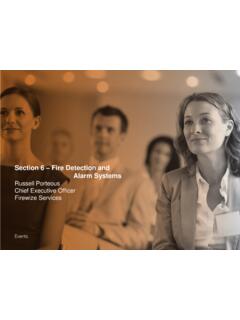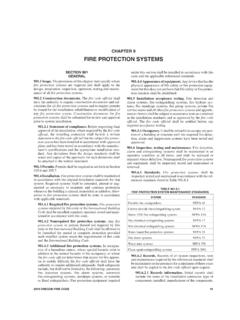Transcription of Fire Detection and Fire Alarm Systems for Buildings BS ...
1 A guidetoFire Alarm Systems DesignBS5839 Part1:2002 Pocket guide toMANAGEMENTSYSTEMSA ssessed to ISO 9001:2008 Cert/LPCB ref. 010 Assessed to ISO 14001:2004 Cert/LPCB ref. 010 EMSMANAGEMENTSYSTEMSCert/LPCB ref. 010 PRODUCTCERTIFICATIONBS 5839-1: 2017 AVAILABLE TO DOWNLOAD ON THE APOLLO APPFire Detection and fire AlarmSystems for Buildings2 Legally you must comply!What is the FSO? fire authorities no longer issue fire certificates and those previously in force now have no legal status.
2 The Regulatory Reform ( fire Safety) Order (FSO) replaced most fire safety legislation with one new Order. It means that any person who has some level of control in premises (normally the employer) must take steps to reduce the risk from fire , consider how to contain a fire should one break out and then also make sure people can safely escape if there is a fire . All fire Alarm designs should be based on an assessment of the risk All fire Risk Assessments should be carried out by a competent person fire Risk assessments must be reviewed regularlyWhat constitutes a fire Risk Assessment and its outcome?
3 Identifying fire hazards such as sources of ignition, fuel or oxygen Identifying all people at risk in and around the premises Evaluating the risk of a fire starting and the risk to people from a fire Removing or reducing fire hazards or risks to people from a fire Protecting people by providing fire precautions Recording the significant findings Preparing an emergency plan Informing and instructing any relevant people, including visitors Providing training for staff Reviewing the fire risk assessment regularly and make changes where necessary Keeping accurate fire risk assessment recordsThe Regulatory Reform ( fire Safety) Order (FSO) became law on 1 October 2006 Where does the Order apply?
4 Virtually all premises and nearly every type of building structure and certain open spaces. If you would like to find out more about how Apollo products can help you comply with the FSO please contact us on 023 9249 2412 or visit our website on download this guide onto your smartphone visit guide is intended to be an aid to designers and installers of fire Detection Systems . It is not to be used as a substitute for BS 5839-1 which should be read in full. In order to help identify the relevant sections, each diagram includes a reference to BS ResponsibilitiesNOTES: (1) BS 5839-1 recommends that a fire Detection system is designed by a competent person, who takes responsibility for completing the design and signing off a Design certificate.
5 This should not be confused with other certificates relating to Installation.(2) If the contract allows, it is suggested that the Designer witnesses testing of the completed system to ensure the original design is still appropriate; the Design certificate can then be completed after any amendments are following recommendations should be followed when designing a fire Detection system : Establish the level of fire protection suitable to the premises type in agreement with the owner/occupier and relevant interested parties Document any reasons to justify variation of design Identify Detection and Alarm zones Raise specification document and building plan to show location of.
6 - All manual call points - All types of detector - All sounders and visual alarms - Any other items of Detection Cable specification for each circuit State the system and equipment to be used Details of other equipment that may be linked into the system to be specified Measures incorporated to limit false alarms Provide a fire plan or cause and effect chart Design certificate signed4 Section 1 Clause 5P1P2L1L2L4 L3 fire Alarm and Detection Systems are categorised in the following way.
7 Property Protection fire SystemsP AFD designed primarily to protect property P1 AFD installed throughout all areasP2 AFD installed only in defined areasLife Protection fire SystemsL AFD designed to primarily protect Human LifeL1 AFD installed throughout all areasL2 AFD installed in defined areas in addition to L3L3 AFD installed in escape routes and rooms or areas opening onto these routesL4 AFD installed in escape routes comprising circulation areas and spaces such as corridors and stairwaysL5 A non-prescriptive system in which protected area(s) and/or the location of detectors is designed to satisfy a specific fire risk objective (other than that of L1 to L4)M system design to be operated manually (no AFD)*AFD Automatic fire Detection5 Section 2 Clause 13 Detection Zones A Detection zone should cover no more than 1 storey, unless total floor area is less than 300m2.
8 Voids in the same fire compartment should be included in the same floor zone. The maximum floor area of a zone should not be greater than 2,000m2, except for some large open plan areas that incorporate manual call points only, which can be extended to 10,000m2. The maximum search distance for the fire fighters to see the seat of the fire within a zone should not exceed 60m assuming the route taken is the worst possible option. Vertical structures like stairwells, lift shafts etc., should be considered as separate zones.
9 A manual call point within a staircase should be connected to the zone associated with that floor and ideally be mounted on the accommodation side of the corridor exit. Automatic sensors on the stairwell remain as part of the stairwell Detection 5 Zone 4 Zone 3 Zone 2 Zone 16 Section 2 Clause 14 DetectionZone 10 DetectionZone 11 DetectionZone 12 DetectionZone 7 DetectionZone 8 DetectionZone 9 DetectionZone 4 DetectionZone 5 DetectionZone 6 DetectionZone 1 DetectionZone 2 DetectionZone 3 Alarm Zone 4 Alarm Zone 3 Alarm Zone 2 Alarm Zone 1 Alarm Zones An Alarm zone is clearly defined within the standard but generally is an area of the building coinciding with the
10 fire compartment boundaries. There must be a clear break between these Alarm zones to ensure alert and evacuation messages are not overheard from adjacent areas. The only other criteria is that an Alarm zone may consist of a number of Detection zones but not vice versa. Alarm zones are only required when phased or staged evacuation is required. It is therefore important that care should be taken to ensure only one message is heard at any one time particularly where two Alarm zones are 2 Clause 2 Clause DETECTOR>600mm XchSMOKE DETECTOR<25mm XThe sensing element of a smoke Detection device (optical smoke or ionisation chamber)








